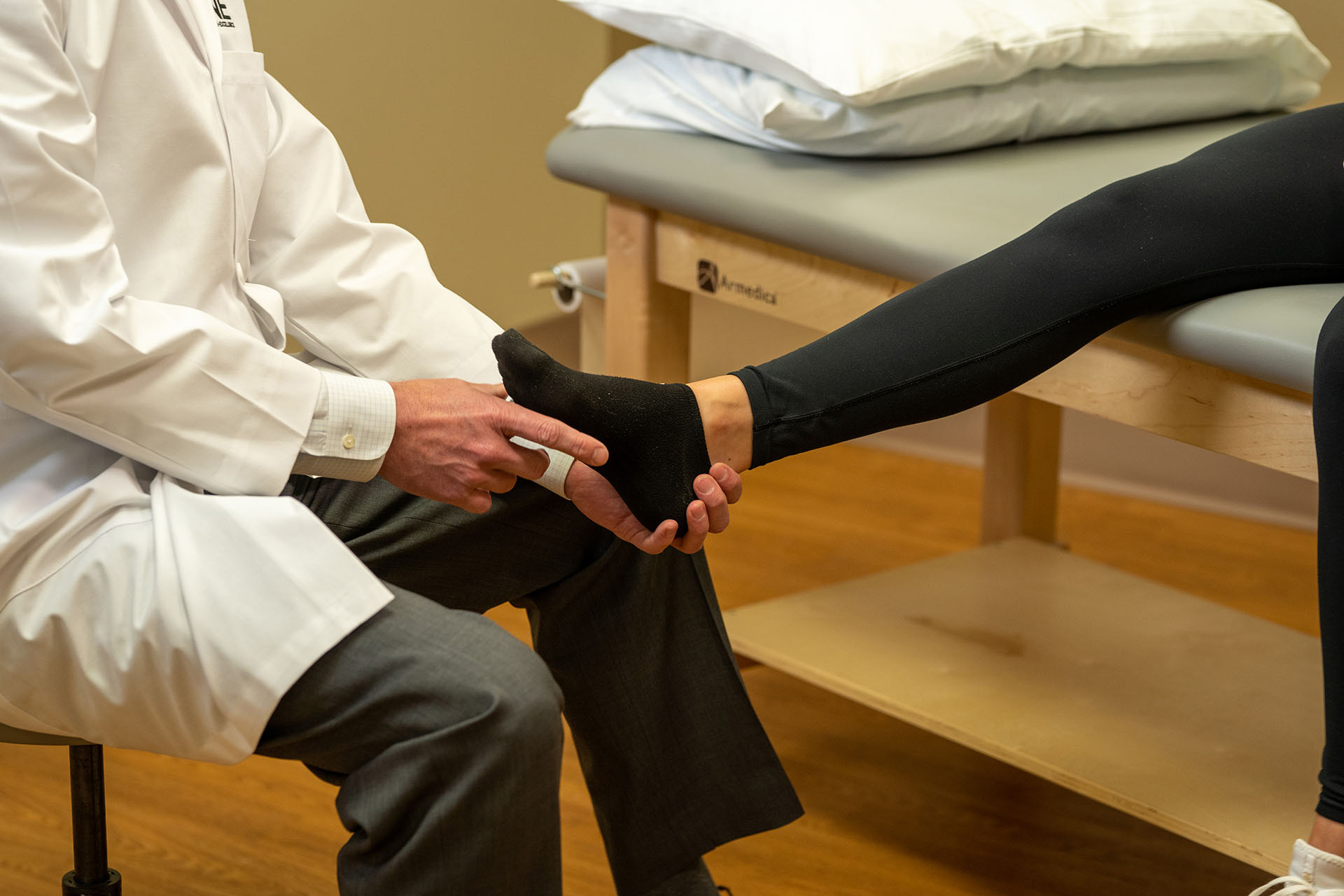Midfoot Fusion
Midfoot fusion is a surgical procedure most commonly employed for the treatment of midfoot arthritis.
Arthritis is the inflammation of joints as a result of degeneration of the smooth cartilage that lines the ends of bones in a joint. This degeneration of the cartilages leads to painful rubbing of the bones, swelling, and stiffness in the joints, resulting in restricted and painful movements.
Midfoot fusion may involve fusion of all the midfoot joints, or in most cases, a fusion of one or a few of the joints into one solid bone. This eliminates joint motion and relieves pain originating from the damaged or arthritic joint.
Symptoms
The Omaha Foot & Ankle Specialists at MD West ONE are able to properly diagnose any condition which may lead to midfoot fusion surgery. If you have the following symptoms or conditions, you may want to make an appointment with one of our Board Certified Specialists.
- Arthritic conditions such as osteoarthritis and rheumatoid arthritis
- Charcot arthropathy
- Flatfoot deformity
- Severe bunions
- Joint displacement
- Acute trauma or injury
- Severe midfoot fracture

Surgical Procedure
In general, midfoot fusion surgery will involve the following steps:
- You will lie on your back on the operating table under regional or general anesthesia.
- One or two surgical cuts are made on top of the foot. The length and the number of incisions will depend upon the number of joints to be fused.
- The underlying muscles are carefully separated to protect the nerves and tendons, and the midfoot joint area is exposed.
- Your surgeon removes any remaining cartilage from the affected joints and prepares the joint surfaces for fusion.
- Stability is accomplished by fusing the joints together with the help of metal implants such as plates and screws. These implants help to immobilize the joints and enable formation of bone across the joint space.
- Bone grafting material may be used to fill up gaps between the bones that may have occurred from the removal of cartilage. The graft material may be taken from another part of your body (autograft) or donor tissue (allograft).
- Your surgeon will also perform any other required repairs in the treatment area.
- Finally, the overlying soft tissue and skin are closed with sutures and sterile bandages are applied.

Post Operative Care
In general, postoperative care instructions and recovery after midfoot fusion surgery will involve the following steps:
- You will be transferred to the recovery area where your nurse will closely observe you for any allergic/anesthetic reactions and monitor your vital signs as you recover.
- You may notice some pain, swelling, and discomfort in the foot area. Pain and anti-inflammatory medications are provided as needed.
- Antibiotics are also prescribed to address the risk of surgery-related infection.
- Apply ice bags over a towel to the affected area for about 15-20 minutes to reduce postoperative pain and swelling.
- Do not weight-bear on the operated leg. A walking boot or a non-weight-bearing cast is recommended for a few weeks to facilitate healing and support the foot.
- Assistive devices such as crutches and walkers are recommended to maintain balance and stability while walking for several weeks.
- At least 6 to 8 weeks may be required for the midfoot bones to fuse adequately for you to start weight-bearing on the operated leg.
- Keep the foot elevated at or above the level of your heart to help minimize swelling and discomfort.
- Start rehabilitation (physical therapy) as recommended by your surgeon to improve range of motion. You should begin appropriate exercises to stretch and strengthen the foot muscles.
- Keep the surgical site clean and dry. Instructions on surgical site care and bathing will be provided.
- Full recovery from midfoot fusion will usually take about 6 months to a year. Refrain from strenuous activities and lifting heavy weights for at least 6 months. Gradual increase in activities over a period of time is recommended.
- Return to sports is recommended only when the foot has regained its normal strength and function and with your doctor’s approval.
- A periodic follow-up appointment will be scheduled to monitor your progress.
How will my walking change after midfoot fusion?
The primary goals of a midfoot fusion are to decrease pain and to improve function. Eliminating the painful motion between the arthritic joint surfaces achieves this, and can improve walking ability.
The midfoot joints on the inside of the foot typically are very stiff and have very little motion. Because there is little motion to begin with, the loss of motion after midfoot fusion surgery is not noticeable and tends to be well-tolerated by patients.
Possible Complications from Ankle Fracture Surgery
All surgeries come with possible complications, including the risks associated with anesthesia, infection, damage to nerves and blood vessels, and bleeding or blood clots.
A major potential complication after midfoot fusion is the failure of the bones to fuse, also referred to nonunion. Other complications can include:
- over-correction or under-correction of deformity (malunion)
- wound healing issues
- pain caused by prominent plates and screws which may require removal of the hardware
- injury to nerves on the top of the foot
When should you contact your healthcare provider or go to an emergency room?
Your healthcare provider will schedule follow-up visits after your procedure but if you are experiencing any of the following symptoms, it's important to schedule an appointment right away or go to the emergency room.
When to see your healthcare provider:
- Warmth or redness around the incisions
- Slow healing
- Oozing pus from the incisions
When to go to the emergency room:
- A high fever
- A sudden loss of sensation in the foot
- Excessive pain not able to be controlled by elevation and medication
- Onset of shortness of breath or chest pain

Meet MD West ONE's foot and ankle specialists and learn more about how they treat Midfoot Fusion.

Kathleen A. Grier, M.D.
Foot & Ankle Specialist

Scott T. McMullen, M.D.
Foot & Ankle Specialist

David J. Inda, M.D.
Foot & Ankle Specialist

Shane Schutt, M.D.
Foot & Ankle Specialist
Download & Save
Click the button below to download the PDF version of this information. By downloading the PDF, you can easily print the resource or save it to your desktop or mobile device for future use.

American Orthopaedic Foot & Ankle Society
All of the foot and ankle surgeons in the practice are recognized members of the American Orthopaedic Foot & Ankle Society. It is the oldest and most prestigious medical society dedicated to the foot and ankle. The mission of the society is to advance science and practice of foot and ankle surgery through education, research, and advocacy on behalf of patients and practitioners. These physicians dedicate their time and energy to improving the patient experience and their knowledge in their field. For more information visit http://www.aofas.org.
MD West ONE Foot & Ankle Specialists:
The Foot & Ankle Specialists are all Board Certified and Fellowship-Trained, meaning they’ve focused their education, training and research on orthopaedic surgery of the foot and ankle.
